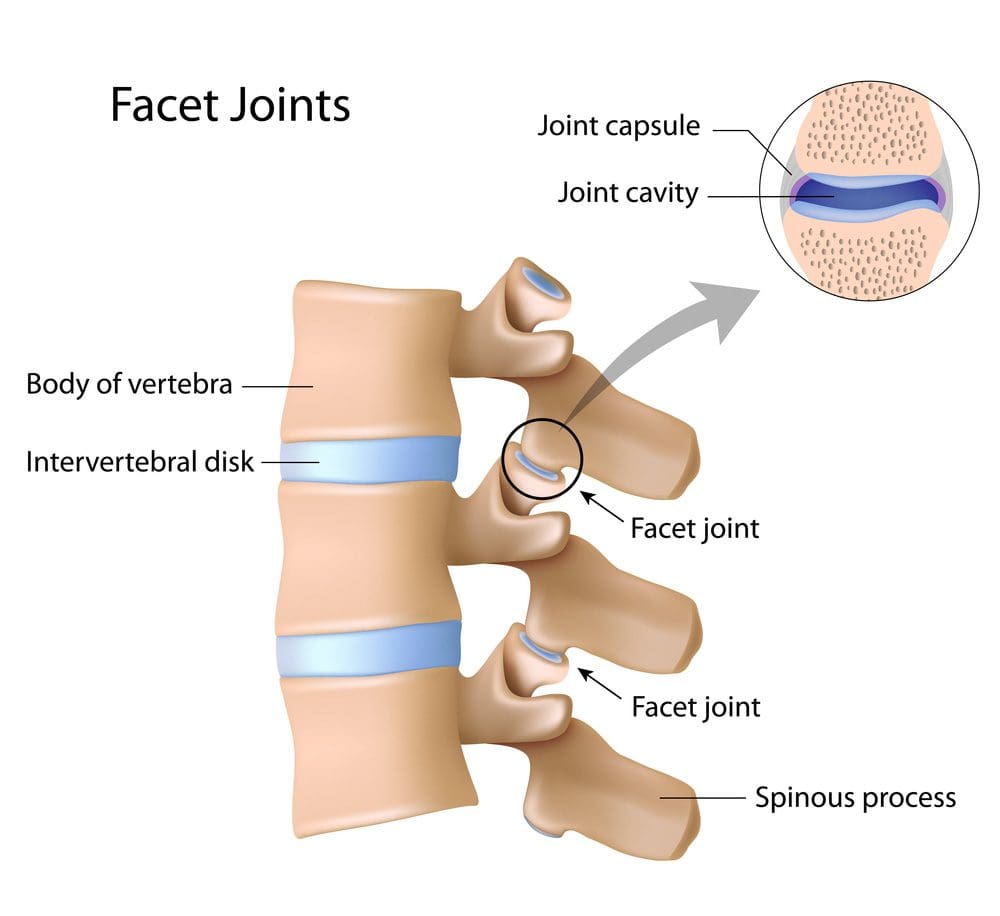A Comprehensive Guide to Facet Arthropathy
Can individuals managing facet arthropathy treat the condition with over-the-counter pain relievers, prescription muscle relaxers, exercise, and chiropractic spinal manipulation?

Facet Arthropathy

Facet arthropathy, or facet osteoarthritis, is arthritis that affects the facet joints in the spine. It causes pain and stiffness due to cartilage degeneration within these joints, often resulting from wear and tear associated with aging. Essentially, it occurs when the small joints in the back of the spine become arthritic and rub against each other painfully.
- It affects the bony protrusions, called facet joints, that connect the spine’s bones.
- Symptoms include neck and back pain that can worsen with standing, bending, or twisting.
- Facet arthropathy is diagnosed using X-rays and other imaging studies.
- Severe cases may require surgery.
Facet Joints
Twenty-four vertebrae form the spine, with two facet joints between each. Facet joints are small joints located at the back of each vertebra in the spine. They allow movement and stability, help maintain the alignment of the spinal bones/vertebrae, and limit excessive motion. The joints and the cushioning intervertebral disc form a three-joint complex between each vertebra.
- The three-joint complex allows the spine to move, including bending, rotating, and extending.
- Synovial fluid lubricates the joints so they can move.
- The intervertebral disc provides flexibility and dissipates compressive loads.
- The facet joints stabilize the spine by constraining rotation and bending.
Symptoms
Arthropathy refers to any disease affecting a joint, including arthritis. Osteoarthritis, also known as arthrosis, is a specific type of arthropathy. It is a non-inflammatory, degenerative arthritis. Pain is the main symptom that is typically worse in the morning when awakening, and in the evening, the pain can also get worse when twisting or bending backward. The symptoms can vary based on the part of the affected spine. Low back pain is the most common, a condition referred to as lumbar facet arthropathy because it affects the lumbar spine of the lower back. (Perolat R. et al., 2018) Common Symptoms include:
- Muscle spasms or cramps.
- Pain that may come in periodic flare-ups
- Pain that worsens with standing or inactivity.
- Dull pain on both sides of the spine.
- Aching pain on both sides of the spine.
- Pain in the lower back, buttocks, shoulders, or back of the skull
- Radiating pain to the buttocks and legs.
- Pain that improves with sitting, leaning forward, or changing positions.
- Pins-and-needles sensations in the hands or feet.
- Clicking sounds when moving the spine.
- Catching sensations when moving the spine.
- Muscle weakness.
Causes
Facet arthropathy causes progressive damage to the spine. Spinal osteoarthritis, aka spondylosis, is the most common cause, but it can also occur with a severe form of spinal arthritis known as ankylosing spondylitis. It is primarily due to age-related wear and tear, but injuries or repetitive stress on the spine can also cause it. Arthritis in the facet joints can develop due to:
- Aging-related wear and tear
- Disc problems
- A previous back injury
- Torn ligaments
- Spinal fractures
Deterioration of facet joints can also cause bony overgrowths called osteophytes or bone spurs, which can cause radiating pain and restrict the spine’s range of motion.
Degeneration
- The facet joints and intervertebral discs degenerate due to age-related wear and tear.
- The cartilage in the facet joints can dry out, crack, and wear down.
- The joint capsule and synovial membrane can inflame or tear, affecting synovial fluid production.
- The loss of cartilage can lead to hypermobility, and the joint can stiffen over time.
Diagnosis
Imaging studies are important to the diagnosis. Several types confirm the diagnosis and also characterize the nature and severity of the condition:
- X-rays provide a plain, black-and-white image of the spinal column.
- CT scan composites multiple X-rays to create a three-dimensional image of the spinal column.
- MRI uses magnetic and radio waves to generate images of soft tissues like ligaments and cartilage.
To confirm the diagnosis, a diagnostic block, which is a small amount of local anesthetic, is injected into a facet joint. The needle placement is directed either with an ultrasound or a CT scan. Facet arthroplasty is confirmed if the injection provides immediate relief (American Academy of Orthopaedic Surgeons, 2022). The healthcare provider will want to exclude other possible causes as part of the differential diagnosis. Conditions that mimic facet arthropathy include:
- Herniated disc
- Psoriatic arthritis
- Reactive arthritis
- Spinal gout
- Spinal compression fracture
Treatment
The treatment varies based on its location and severity. Generally, conservative treatments are used before more invasive procedures are considered.
Lifestyle Changes
- Initially, a healthcare provider may recommend rest and avoiding aggravating movements, including any activity that involves bending or twisting.
- Activities that take the weight off the facet joint, such as sitting, leaning forward, or changing positions, may help ease the pain.
- Patients may also be advised to adjust their sleep positions to take the pressure off facet joints.
- Options included curling up on your side or lying on your back with the knees supported with pillows.
Medications
If a diagnostic block is used, a patient may not need medications immediately. However, as the anesthetic starts to wear off, the patient may be prescribed over-the-counter or prescription pain relievers based on the severity of the pain. These can include:
- Analgesics like Tylenol
- Nonsteroidal anti-inflammatory drugs like Advil or Aleve
- Muscle relaxants like Lloresal for acute back pain
- Antidepressants like Cymbalta for chronic back pain
Physical Therapy
Physical therapy is a major part of the treatment of lower back pain. The treatment plan will include personalized exercises to strengthen the core muscles and avoid stress on the spine. Examples include:
- Mechanical traction and non-surgical to decompress the spine.
- Knee-to-chest stretches, hugging your knees for 30 to 60 seconds.
- Walking 10 to 20 minutes per day.
- Aquatic therapy to alleviate pressure on the spine.
Surgery
If conservative measures don’t work or provide sufficient relief, a healthcare provider may recommend specialist procedures or surgeries that include:
- Lumbar intra-articular injections deliver an anesthetic or corticosteroid into the spine for longer-lasting pain relief.
- Sinuvertebral nerve ablation destroys spinal nerves with a strong electrical current.
- Extracorporeal shockwave therapy ESWT delivers low- or high-energy electrical pulses to help ease pain.
- Spinal fusion surgery involves fusing two or more vertebrae to eliminate movement and pain in the facet joints.
- Facet rhizotomy is a surgical procedure used to sever one of the nerves supplying the facet joint.
- Stem cell regeneration is an experimental procedure in which stem cells are harvested and injected into damaged joints to restore function.
Injury Medical Chiropractic and Functional Medicine Clinic
Injury Medical Chiropractic and Functional Medicine Clinic works with primary healthcare providers and specialists to build optimal health and wellness solutions. We focus on what works for you to relieve pain, restore function, prevent injury, and help mitigate issues through adjustments that help the body realign itself. They can also work with other medical professionals to integrate a treatment plan to resolve musculoskeletal problems.
Facet Syndrome Pain Treatment
References
Perolat, R., Kastler, A., Nicot, B., Pellat, J. M., Tahon, F., Attye, A., Heck, O., Boubagra, K., Grand, S., & Krainik, A. (2018). Facet joint syndrome: from diagnosis to interventional management. Insights into imaging, 9(5), 773–789. https://doi.org/10.1007/s13244-018-0638-x
American Academy of Orthopaedic Surgeons. (2022). Spinal injections. https://orthoinfo.aaos.org/en/treatment/spinal-injections/

